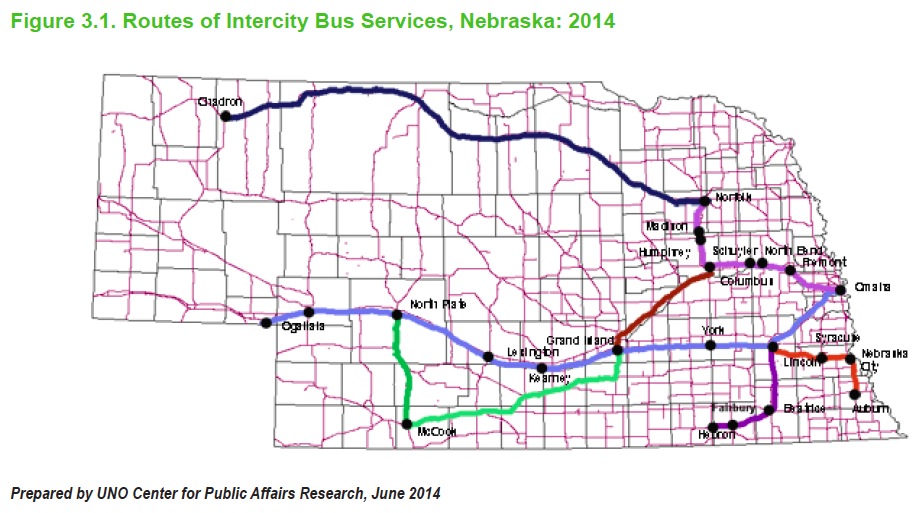UNO CENTER FOR PUBLIC AFFAIRS RESEARCH
I. INTRODUCTION
The Federal Transit Administration (FTA) defines intercity bus service as regularly scheduled bus service for the general public that operates with limited stops over fixed routes connecting two or more urban areas not in close proximity, that has the capacity for transporting baggage carried by passengers and that makes meaningful connections with scheduled intercity bus service to more distance points, if such service is available. In rural states like Nebraska, intercity bus service is most often used to connect rural areas with larger urbanized areas.
The Nebraska Department of Roads (NDOR) has partnered with the University of Nebraska at Omaha Center for Public Affairs Research (CPAR) to conduct a statewide intercity bus study. The objectives of this study include the following.
- Identify existing intercity bus service.
- Interview intercity bus providers.
- Conduct public information open houses to identify ridership demographics.
- Gather public input to identify gaps in service.
- Summarize the information gathered.
- Develop an action plan to address intercity bus needs.
- Share the study findings with the transportation community and general public.
II. SUBSIDIZED INTERCITY BUS PROVIDERS
Currently, NDOR subsidizes four intercity bus providers with FTA Section 5311 funds. The providers who request funding are required to submit an operating assistance application annually. Approved applicants submit monthly invoices for reimbursement. NDOR reimburses the operating deficit using 50% Federal and 50% State funds. Because the State intercity bus funds are capped at $95,000 annually, NDOR expends the state funds and then continues to support the intercity bus providers with 50% Federal funds.
III. CURRENT INTERCITY BUS SERVICES AVAILABLE IN NEBRASKA
There are seven intercity bus service providers currently providing service on various routes across the state of Nebraska. As described previously, four are subsidized by the State of Nebraska and three are not. In addition, one feeder service, subsidized directly through FTA, is included in this study.
The routes and stops of four of the providers are defined by a regular schedule with scheduled stops. Three providers have a regular schedule with scheduled stops but also accommodate additional stops on demand. Reservations must be made for additional stops and stops must be directly on the route between the scheduled stops. The additional stops may require an additional fee. There is usually a limited number of additional stops that can be made on each run in order to maintain the route schedule. The feeder service does not have a regular schedule or stops but provides services on demand.
The map below shows the scheduled routes and stops for the seven intercity bus service. Some routes are covered by more than one provider, for example, Black Hills Stage Lines, Burlington Trailways, and Dashabout Shuttle Company cover the entire Interstate 80 route from Omaha to the Colorado border. As described in Table 3.1, additional stops on many of the routes are available on demand.
Download full version (PDF): Assessment of Intercity Bus Services in Nebraska
About the UNO Center for Public Affairs Research
www.unomaha.edu
The Center for Public Affairs Research is a research and community outreach unit of the UNO College of Public Affairs and Community Service.
Tags: NB, NDOR, Nebraska, Nebraska Department of Roads, Omaha, University of Nebraska, UNO, UNO Center for Public Affairs Research







 RSS Feed
RSS Feed